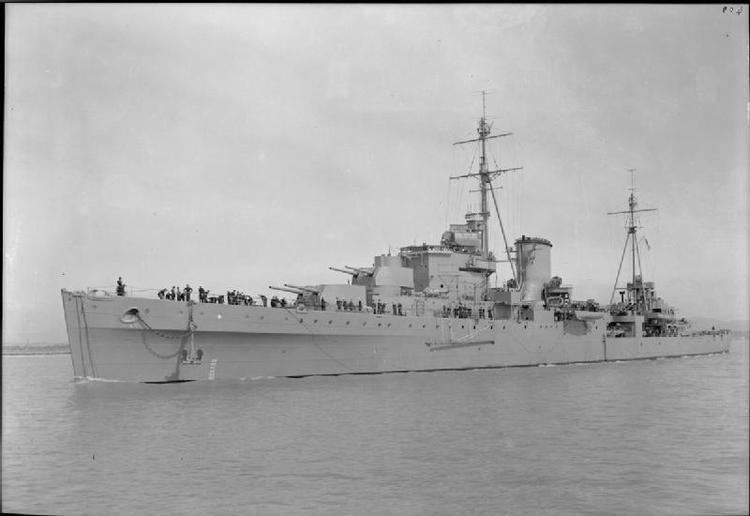5 cruisers 3 destroyers Location Mediterranean Sea | Date 28 June 1940 | |
 | ||
1 cruiser lightly damaged 1 destroyer sunk
150–180 dead
47 captured Combatants United Kingdom, Kingdom of Italy, Australia Similar Battle of the Strait of Otranto, Battle of the Duisburg, Battle of the Tarigo Convoy, Operation Abstention, Raid on Algiers | ||
Battle of the espero convoy
The Battle of the Espero Convoy was the first Second World War surface engagement between Italian and Allied warships. It took place southwest of Crete on 28 June 1940, after a force of seven cruisers and 16 destroyers, preparing to escort three Allied convoys to Alexandria, were informed of the presence of an Italian flotilla of three destroyers. The Italian warships were bound from Taranto to Tobruk, carrying an anti-tank army unit to North Africa.
Contents
Background
On 10 June 1940, Italy declared war on Britain and France. The Italian High Command (Comando Supremo) expected a British Army advance into Cyrenaica led by armoured forces, and decided that an anti-tank unit should be moved to Tobruk as soon as possible. The unit comprised ten anti-tank guns, 120 short tons (110 t) of ammunition, and 162 soldiers.
Prelude
The Italians chose three Turbine-class destroyers to transport the anti-tank unit, for their high speed (36 kn (41 mph; 67 km/h)) and loading capacity. The three chosen were Espero (flagship), Zeffiro and Ostro. The Italian flotilla was commanded by Capitano di Vascello Enrico Baroni. Two smaller WWI-era escort vessels, the Pilo and the Missori, which carried 52 troops and additional supplies, departed independently for Tobruk some hours later.
At the same time, three Allied convoys—two from Malta and another from Greece—were to be brought to Alexandria, covered by seven cruisers (two light cruisers—HMS Capetown and Caledon—and five of the 7th Cruiser Squadron: HMS Orion (flagship), Liverpool, Gloucester, Neptune and HMAS Sydney) and 16 destroyers. The British warships were commanded by Vice-Admiral John Tovey. The Allied operation was supported by Short Sunderland flying boats from Alexandria and Malta.
Battle
The Italian destroyers were found at noon by two Sunderlands some 50 mi (43 nmi; 80 km) west of Zante island. They were within striking range of Tovey’s 7th Squadron, so he ordered them to intercept the Italians in two divisions.
The first 6 in (150 mm) salvoes from the Allied cruisers were fired at 18:30 at the surprised Italian flotilla at a range of 18,000 yd (16,000 m). Baroni realised that—despite the best speed of his ships—they were hopelessly outgunned. He therefore decided to sacrifice Espero in order to enable the other two to escape: Espero laid smokescreens and conducted evasive manoeuvres. Zeffiro and Ostro headed safely to the southwest at full speed.
Despite heavy firing, Espero was not hit until 19:20, when the range had closed to 14,000 yd (13,000 m). By this time, Tovey had given up the chase of the other two destroyers. The 7th Squadron expended about 5,000 shells before Espero was sunk, after 130 minutes of fierce fighting.
A single Italian 4.7 in (120 mm) shell hit HMS Liverpool just 3 ft above the waterline, but caused little damage. HMAS Sydney rescued 47 men from the Italian destroyer, and six others were later found alive by an Italian submarine almost 20 days later. Captain Baroni died aboard his ship, and was posthumously awarded the Medaglia d´oro al valor militare.
Aftermath
Zeffiro and Ostro both reached Benghazi the next day and arrived at Tobruk shortly after. Two-thirds of the convoy had been saved. The smaller Pilo and Missori also arrived safely with their valuable cargoes. Conversely, the massive expenditure of shells by the British cruisers exacerbated a shortage of ammunition at Alexandria so that the planned Malta convoys were postponed for two weeks. The British cruisers had fired nearly 5,000 rounds at the Italian destroyers.
There were lessons learned by both sides after this battle. For the Allies, the battle showed that a daylight naval action at long range was unlikely to be decisive when the enemy units outmatched one's own speed. For the Italians, this was a grim lesson about the importance of well-coordinated air surveillance. Had Italian aircraft spotted the Allied cruisers before they came within range, all three destroyers would have escaped unscathed.
Order of Battle
(F) denotes flagship
Light cruisers: Orion (F), Neptune, HMAS Sydney, Gloucester, and Liverpool.
Destroyers: Espero (F), Ostro, Zeffiro
